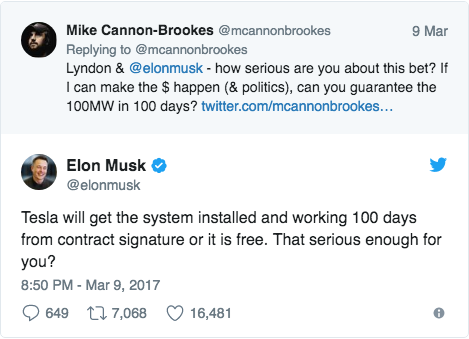![]()
Tech billionaire and business magnate Elon Musk attempted to address power outages in South Australia and Peurto Rico. Musk made good on promises to quell the recent spate of power outages plaguing Australia due to a recent storm.
Well ahead of the 100-day schedule, Musk connected his massive lithium-ion battery to the South Australian power grid 63 days after boasting to tech company Atlassian founder Mike Cannon-Brookes on Twitter and signing the $200 million contract.
Steven Bentley, a 30-year native of Australia now living in the United States, regularly contacts his cousin, a plastics manufacturer in Australia, whose firsthand experience with the power outages directly influences his ability to produce plastics. “Some of the machinery that he runs is quite power-hungry,” Bentley said. “So he definitely feels that every month when he goes to pay the power bill.”
Bentley ascribes much of the power problem to recent developments within the Australian legislation. Bentley laments several treaties that Australia, once resource-rich and heavily dependent on coal and oil for power generation, has signed on to. “Australia has shifted to carbon credits and signed on to climate change treaties, and because of that, they’ve closed down a lot of the coal power stations,” Bentley said. “That change is a government that strongly supported the Climate Accord, so a lot of the coal and power stations closed down in the states.”
Bentley said that Musk’s providing battery power to South Australia will greatly stabilize the situation, but is not a long-term solution. “South Australia took the step of trying to solve this problem in the short term, and I think the battery solution Elon Musk proposed is a good one because it means that at least in the short term there’s some backup power.”
Bentley proposed a different solution for the overall power situation: legislation. “I think the best solution is the legislation that they’re putting through now to bring back on board some of the natural gas that they’ve sold, that they’re under contract to sell overseas,” Bentley said.
While Musk’s words on Twitter may have yielded electricity for the residents of South Australia, on the other side of the world, another subject of Musk’s tweets may have fallen to the wayside. On Oct. 5, about 15 days after the landfall of Hurricane Maria on Puerto Rico, Musk noticed the efforts of the Puerto Rican government to restore power and tweeted a suggestion reminiscent his promise to South Australia:
“The Tesla team has done this for many smaller islands around the world, but there is no scalability limit, so it can be done for Puerto Rico too. Such a decision would be in the hands of the PR govt., PUC, any commercial stakeholders and, most importantly, the people of PR.”
Puerto Rican governor Ricardo Rossello promptly responded:
“@elonMusk Let’s talk. Do you want to show the world the power and scalability of your #TeslaTechnologies? PR could be that flagship project.”
Since then, little has been said about the possibility of Tesla technology relieving what is now the longest blackout in U.S. history.
Carmen Borrero, a 43-year-old Puerto Rican native now living in Springdale, Arkansas, recalls the power situation before Maria made landfall. “It has not been easy,” Borrero said. “I lived through Hurricane George in Puerto Rico and I spent two months without electricity and a month without running water.”
Borrero’s family is now in a very similar situation. “My family’s town has electricity right now, but they had to wait for almost two months for electric power,” Borrero said. “They got running water a lot faster. Three weeks after the hurricane they had running water.”
Borrero recognizes that Maria is much more severe, as relief efforts have taken much longer to bolster the struggling power and natural resource infrastructure. “I think that five months from today the electric system of Puerto Rico will be fully recovered,” Borrero compared. “With George, it only took three months to recover electric power. The difference between hurricane Maria and George is that Maria’s effects were felt all over the island. George only affected the southern part of Puerto Rico.”
“Puerto Rico is an area that is used to suffer from hurricanes and we’ve always seen the help of the Federal Government,” Borrero said. “This is the first time that we’ve felt abandoned by the Federal Government during a time of crisis caused by natural disasters.”
Tesla is a multi-billion dollar electric business, so it would not be economically beneficial for Musk to provide relief without a tangible return on his investment. Bentley observes, “private interests have a heavy interest in driving the price of electricity up. It’s to their benefit, but not to the consumer.”
For now, the residents of Puerto Rico make do with what they have, relying on the aid trickling in from the government and humanitarian relief organizations, but mostly on each other. “It is not easy, but for me it is better to help them from here than flying to the island,” Borrero said. “I can be of more help from here, where I can work and send money to them.”
Borrero continues to find hope in her family’s situation. “Sometimes, during the time of tragedy is when you see the people uniting to help and support each other,” Borrero said. “Sometimes these things happen for good.”





